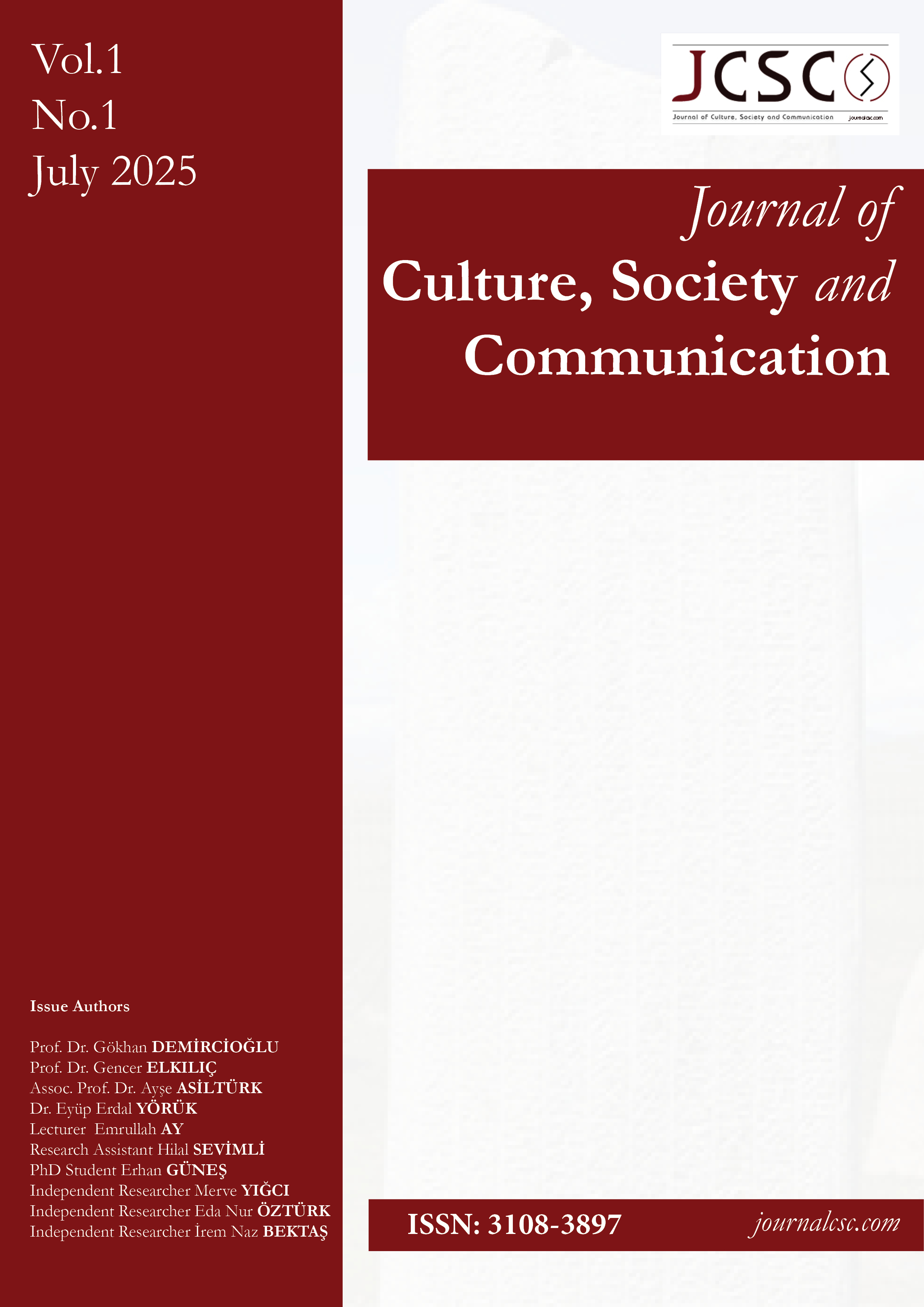Use of Advertising Appeal in Magazine Advertisements: Atlas Magazine Example
DOI:
https://doi.org/10.5281/zenodo.15977930Keywords:
Advertising, Magazine Advertising, Advertising Appeals, Emotional AppealAbstract
With the development of global competition, the need for brands to differentiate from each other has emerged. This differentiation is reflected not only in the quality of the product or service offered, but also in the advertising messages that introduce these products and services to target audiences. One of the most effective methods of differentiating advertising messages is the use of advertising appeals. Brands use two types of advertising appeals, rational and emotional, to differentiate their advertising messages. The type of advertising appeal to be used varies depending on various variables such as the brand's goals and the characteristics of the audience it wants to reach. This study aims to analyze how advertising appeals are used in magazine advertisements as an advertising medium that maintains its effectiveness in the context of sectoral diversity. In this direction, 78 advertisements in Atlas magazine between January 2021 and May 2021 were examined using purposive sampling and content analysis, one of the qualitative research methods. As a result of the analysis, percentages were calculated and the most used appeals and almost never used appeals were determined. The most commonly used emotional appeal in magazine ads is the quality appeal. They frequently incorporate the quality element into their ads to meet customer demands and expectations. It has been analyzed that the emotional appeals of guilt, scarcity, music, and individuality are relatively less prevalent. This also suggests that brands avoid using guilt and scarcity appeals to avoid creating negative impressions in the minds of magazine buyers.
References
Ateş, S. (2016). Siyasal Reklamlarda Duygusal Çekicilik Kullanımı: 7 Haziran 2015 Genel Seçimlerinde Siyasal Partiler Tarafından Üretilen Reklam Filmlerinin Analizi. Karadeniz Teknik Üniversitesi İletişim Araştırmaları Dergisi, 6(2), 85-103.
Albers-Miller, N. D. & Stafford, M. (1999). An international analysis of emotional and rational appeals in services vs. goods advertising. Journal of Consumer Marketing, 16(1), 42-57. http://dx.doi.org/10.1108/07363769910250769
Becan, C. (2014). Antiütopik İdeolojinin üretilmesinde reklam çekiciliklerinin rolü (Unpublished doctoral dissertation). Institute of Social Sciences, İstanbul University.
Belch, G. E., & Belch, M. A. (2021). Advertising and promotion: An integrated marketing communications perspective (12th edition). McGraw-Hill Irwin.
Büyücek, N., Knox, K. & Rundle-Thiele, S. (2019). A positive behavior al approach: Identifyingc theoretical factors influencing moderate drinking practices. Social Marketing Quarterly, 25(2), 107- 122. http://dx.doi.org/10.1177/1524500419830442
Chang, H. J., O’Boyle, M., Anderson, R. ve Suttikon, C. (2016). An fMRI study of advertising appeals and their relationship to product attractiveness and buying intentions. Journal of Consumer Behaviour, 15, 538-548. https://doi.org/10.1002/cb.1591
Clow, K. E., & Baack, D. (2009). Marketing management: A customer-oriented approach
Davidson, H. L. (1908). The rhetoric of Aristotle. Foresman.
Davies, M. (1993). Developing combinations of message appeals for campaing management. European Journal of Marketing, 27(1), 45-63. https://doi.org/10.1108/03090569310024558
Dereli, A.B. (2023). Sosyal medya reklamcılığı. İletişim Ansiklopedisi.
Dix, S., & Marchegiani, C. (2013). Advertising appeals. Journal of Promotion Management, 19(4), 393-394. http://dx.doi.org/10.1080/10496491.2013.817218
Drewniay, B. L. & Jewler, A. J. (2013). Creative strategy in advertising. Cengage Learning.
Elden, M., Ulukök, Ö. & Yeygen, S. (2015). Şimdi reklamlar…İletişim Yayınları.
Gallopel-Morvan, K., Gabriel, P., Le Gall-Ely, M., Rieunier, S. & Urien, B. (2011). The use of visual warnings in social marketing: The case of Tobacco. Journal of Business Research, 64(1): 7-11.http://dx.doi.org/10.1016/j.jbusres.2009.09.012
Good, A. & Abraham, C. (2007). Measuring defensive responses to threatening messages: A meta-analysis of measures. Health Psychology Review, 1(2), 208-229. http://dx.doi.org/10.1080/17437190802280889
Hetsroni, A. (2007). The relationship between values and appeals in Israeli advertising: A smallest space analysis. Journal of Advertising, 29(3), 55-68.
Hornik, J., Ofir, C., & Rachamim, M. (2017). Advertising appeals, moderators, and impact on persuasion: A quantitative assessment creates a hierarchy of appeals. Journal of advertising research, 57(3), 305-318. http://dx.doi.org/10.2501/JAR-2017-017
Jovanović, P., Vlastelica, T., & Kostić, S. C. (2016). Impact of advertising appeals on purchase intention. Management Journal of Sustainable Business and Management Solutions in Emerging Economies, 21(81), 35-45. http://dx.doi.org/10.7595/management.fon.2016.0025
Khan, K. M. & Khan, M. (2006). The encyclopaedic dictionary of marketing. Sage Publications.
Kotler, P. & Armstroang, G. (2006). Principles of marketing (11th edition). Pearson Prentice Hall.
Krippendorf, K. (2004). Content analysis an introduction to its methodology. Sage Publications.
Lin, L.Y. (2011). The impact of advertising appeals and advertising spokespersons on advertising attitudes and purchase intentions. African. Journal of Business Management, 5(21), 8446-8457. http://dx.doi.org/10.5897/AJBM11.925
Moriarty, S. E. (1991). Creative advertising: Theory and practice (2nd edition). Prentice-Hall.
Panda, T. K., Panda, T. K., & Mishra, K. (2013). Does emotional appeal work in advertising? The rationality behind using emotional appeal to create favorable brand attitude. The Iup Journal Of Brand Management, 10(2), 7-23.
Pelsmacker, P.D., Maison, D. & Geuens, M. (2002). Emotional and rational advertising messages in positive and negative Polish media contexts. New Directions in International Advertising Research, 12, 114-128. http://dx.doi.org/10.1016/S1474-7979(02)12023-0
Pringle, H. & Field, P. (2008). Brand immortality how brands can live long and prosper. Kogan Page Limited.
Ray. M., L. (1982). Advertising and communication management. Prentice-Hall, Inc.
Raza, S.H., Abu Bakar, H. ve Mohamad, B. (2018). Relationships between the advertising appeal and behavioral intention: The mediating role of the attitude towards advertising appeal and moderating role of cultural norm. Journal of Business and Retail Management Research,12, 185-193. http://dx.doi.org/10.24052/JBRMR/V12IS02/RBTAAABITMROTATAAAMROCN
Stafford, M. R., & Day, E. (2013). Retail services advertising: The effects of appeal, medium, and service. Journal of Advertising, 24(1), 57-71. http://dx.doi.org/10.1080/00913367.1995.10673468
Tellis, G. J. (2004). Effective advertising: Understanding when, how and why advertising works. Sage Publicattions
Uğur, H. (2021). Reklamlarda korku ve tiksinti çekiciliğinin kullanımı: Rexona “sarı lekelere son” reklam film analizi. International Journal of Social and Humanities Sciences Research, 8(71), 1356-1364. http://dx.doi.org/10.26450/jshsr.2482
Weilbacher, W.M. (2001). Points of view: Does advertising cause a hiararchy of effects. Journal of Advertising Research, 41(6), 19-26. http://dx.doi.org/10.2501/JAR-41-6-19-26
Yönet, Ö. (2022). Duygular. A.A. Bir & H. K. Suher (Ed.). In Reklam Teorileri I (pp. 345-391). The Kitap.
Yousef, M., Rundle-Thiele, S., & Dietrich, T. (2023). Advertising appeals effectiveness: a systematic literature review. Health Promotion International, 38(4), http://dx.doi.org/10.1093/heapro/daab204
Zhang, H., Sun, J., Liu, F., & G. Knight, J. (2014). Be rational or be emotional: Advertising appeals, service types and consumer responses. European Journal of Marketing, 48(11-12), 2105-2126 http://dx.doi.org/10.1108/EJM-10-2012-0613
Downloads
Published
How to Cite
Issue
Section
License
Copyright (c) 2025 Merve YIĞCI

This work is licensed under a Creative Commons Attribution 4.0 International License.







